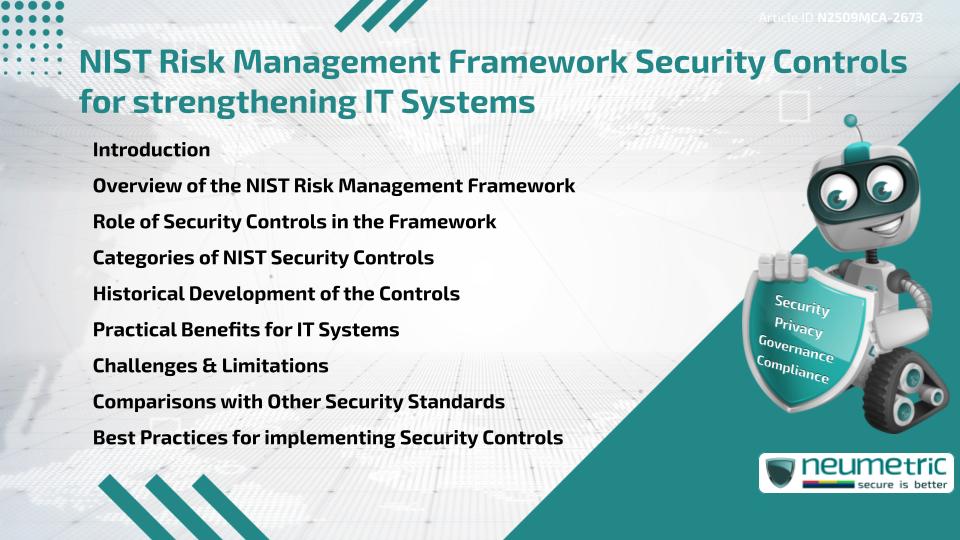Table of Contents
ToggleIntroduction
The NIST Risk Management Framework Security Controls provide a structured way to protect Information Systems from Threats, Vulnerabilities & Risks. These Controls cover both Technical & Non-technical measures designed to safeguard Confidentiality, Integrity & Availability. By implementing them, Organisations not only enhance Compliance but also build a resilient IT Environment. This article explores the Framework’s role, types of Controls, history, benefits, challenges & comparisons with other standards.
Overview of the NIST Risk Management Framework
The National Institute of Standards & Technology [NIST] developed the Risk Management Framework [RMF] to integrate Risk Management into every stage of an Information System’s Life Cycle. It provides a repeatable process for identifying, implementing & monitoring Controls. The RMF ensures Organisations make informed decisions about Risk & Security, balancing Operational needs with Regulatory requirements.
Role of Security Controls in the Framework
Security Controls are the backbone of the RMF. They serve as Safeguards against Potential Threats & help Organisations meet Compliance obligations. Each control is tailored to address specific aspects of Risk, such as Access Management, Data Protection & Incident Response. Together, they form a layered defense system that reduces Vulnerabilities & strengthens trust in IT Systems.
Categories of NIST Security Controls
The NIST Risk Management Framework Security Controls are grouped into several categories:
- Management Controls: Focus on Risk Assessment, Planning & Oversight.
- Operational Controls: Cover Policies, Training & Incident Handling.
- Technical Controls: Include Encryption, Firewalls & Authentication Mechanisms.
These categories ensure that security is addressed from both Organisational & Technical perspectives. Controls are further detailed in NIST Special Publication 800-53, which provides a comprehensive catalogue.
Historical Development of the Controls
The NIST Security Controls evolved from the Federal Information Security Management Act [FISMA] requirements of 2002. Initially tailored for Federal Agencies, they were later expanded to support Contractors & Private Organisations. Over time, the Controls were updated to address new Cybersecurity Threats, ensuring they remain relevant for modern IT Environments.
Practical Benefits for IT Systems
Implementing NIST Risk Management Framework Security Controls provides several advantages:
- Stronger defense against Cyber Threats
- Enhanced Regulatory Compliance
- Improved Incident Detection & Response
- Reduced Risk of Data Breaches
- Increased Stakeholder Trust & Confidence
These benefits demonstrate that the Controls not only ensure Compliance but also serve as a strategic Investment in Organisational resilience.
Challenges & Limitations
Despite their strengths, the Controls come with challenges. Organisations may face Resource constraints, particularly in Small or Medium-sized Businesses. The complexity of implementation can also overwhelm teams unfamiliar with NIST guidelines. Continuous Monitoring requires dedicated Personnel & Tools, which can strain Budgets.
Comparisons with Other Security Standards
The RMF & its Controls are often compared with ISO 27001 & COBIT. While ISO 27001 focuses on establishing a global Information Security management system [ISMS], COBIT emphasises IT Governance. The RMF distinguishes itself by its detailed control catalogue & close alignment with U.S. Federal Compliance Standards. Many Organisations combine these frameworks to achieve comprehensive security.
Best Practices for implementing Security Controls
To maximise the effectiveness of Security Controls, Organisations should:
- Conduct regular Risk Assessments
- Train Staff on Security Awareness
- Automate monitoring & reporting
- Integrate Controls into daily operations
- Perform Internal Audits to validate Compliance
By applying these practices, Organisations strengthen their IT Systems & reduce long-term Risks.
Takeaways
- Vital for strengthening IT Systems against evolving Threats
- Provide a structured, layered Risk Management approach
- Deliver both Compliance & Resilience benefits
- Resource-intensive but essential
- Cornerstone of effective Cybersecurity practices
FAQ
What are NIST Risk Management Framework Security Controls?
They are Safeguards developed by NIST to protect IT Systems against Risks & Threats while ensuring Compliance with Federal Standards.
Why are Security Controls important for IT Systems?
They reduce Vulnerabilities, support Regulatory Compliance & enhance overall resilience against Cyberattacks.
How many categories of Controls exist in the RMF?
The Controls are grouped into Management, Operational & Technical categories.
Do Private Companies need to implement NIST Controls?
While mandatory for Federal Agencies, Private Companies adopt them voluntarily to improve Security & meet Partner or Customer requirements.
How are NIST Controls different from ISO 27001?
NIST Controls focus on detailed Safeguards for IT Systems, while ISO 27001 provides a broader Framework for managing Information Security.
What challenges exist in implementing these Controls?
Challenges include high Resource requirements, complexity & the need for Continuous Monitoring.
Can Organisations combine NIST Controls with other standards?
Yes, many Organisations use them alongside ISO 27001 or COBIT for a comprehensive security approach.
Need help for Security, Privacy, Governance & VAPT?
Neumetric provides organisations the necessary help to achieve their Cybersecurity, Compliance, Governance, Privacy, Certifications & Pentesting needs.
Organisations & Businesses, specifically those which provide SaaS & AI Solutions in the Fintech, BFSI & other regulated sectors, usually need a Cybersecurity Partner for meeting & maintaining the ongoing Security & Privacy needs & requirements of their Enterprise Clients & Privacy conscious Customers.
SOC 2, ISO 27001, ISO 42001, NIST, HIPAA, HECVAT, EU GDPR are some of the Frameworks that are served by Fusion – a SaaS, multimodular, multitenant, centralised, automated, Cybersecurity & Compliance Management system.
Neumetric also provides Expert Services for technical security which covers VAPT for Web Applications, APIs, iOS & Android Mobile Apps, Security Testing for AWS & other Cloud Environments & Cloud Infrastructure & other similar scopes.
Reach out to us by Email or filling out the Contact Form…


